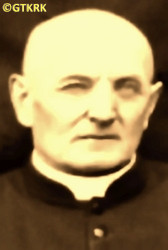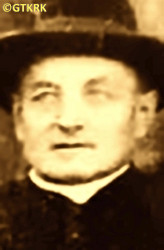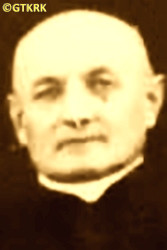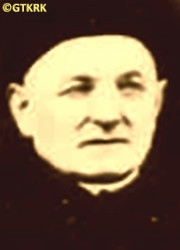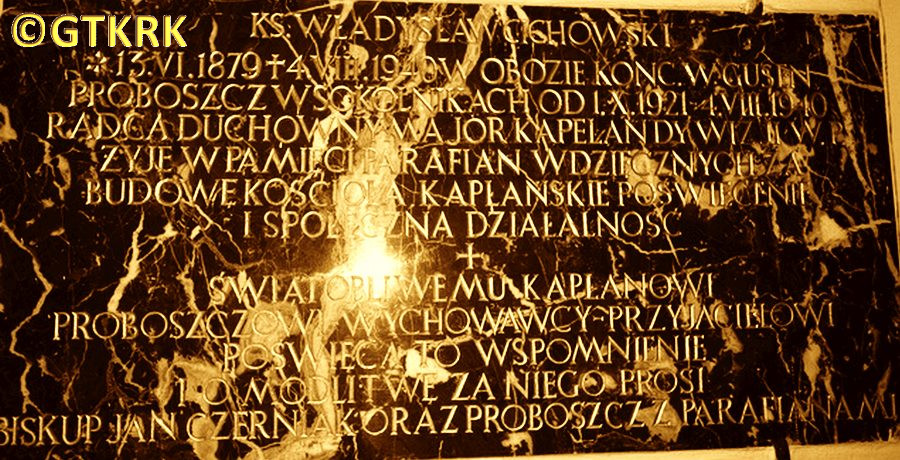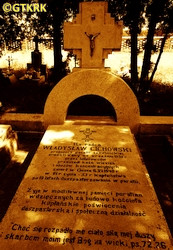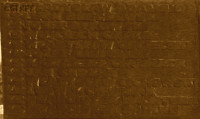Roman Catholic
St Sigismund parish
05-507 Słomczyn
85 Wiślana Str.
Konstancin deanery
Warsaw archdiocese, Poland
full list:
displayClick to display full list

searchClick to search full list by categories
wyświetlKliknij by wyświetlić pełną listę po polsku

szukajKliknij by przeszukać listę wg kategorii po polsku

Martyrology of the clergy — Poland
XX century (1914 – 1989)
personal data
surname
CICHOWSKI
forename(s)
Vladislav (pl. Władysław)
function
diocesan priest
creed
Latin (Roman Catholic) Church RCmore on
en.wikipedia.org
[access: 2014.09.21]
diocese / province
Gniezno and Poznań archdiocese (aeque principaliter)more on
www.archpoznan.pl
[access: 2012.11.23]
RC Military Ordinariate of Polandmore on
en.wikipedia.org
[access: 2014.12.20]
honorary titles
Ad Honores Spiritual Counselor
(c. 1933)
date and place
of death
25.06.1940

KL Gusen Iconcentration camp
today: n. St. Georgen an der Gusen, Sankt Georgen an der Gusen, Perg dist., Salzburg state, Austria
more on
en.wikipedia.org
[access: 2022.01.09]
alt. dates and places
of death
04.08.1940 („official” date)
details of death
Organizer and participant — as chaplain of fighting units — of the Greater Poland Uprising of 1918‐1919 in Poznań. After the city was liberated by the insurgents — it finally happened on 06.01.1920 — administrator of the insurgent military parish in Poznań and chaplain of the 8th Greater Poland Rifle Regiment as part of the 2nd Greater Poland Rifle Division (formed in 03.1919, after the armistice of 16.02.1919 in Trier, in which the Allies victorious in World War I recognized the insurgent army as an allied armed force) — on 17.01.1920 the regiment was renamed the 62nd Infantry Regiment, and the division the 15th Greater Poland Infantry Division. The Regiment — under the Treaty of Versailles, signed on 28.06.1919, which recognised the right of the reborn Poland to the lands of the Prussian partition (i.a. Greater Poland), and which came into force on 10.01.1920 — entered on 20.01.1920 Bydgoszcz, which meant that Poland took over power in that city.
Next it took part in the Kiev Expedition of Polish troops, i.a. on 25‐26.04.1920 captured Berdychiv. In the summer of 1920 promoted and appointed chaplain of the 17th Greater Poland Infantry Division. The division took part in the Polish–Russian war of 1919‐1921, fighting, among others in the lost battle of Lida (14‐17.07.1920) and the victorious battles on the Wkra river (14‐18.08.1920) — during victorious Battle of Warsaw (known as the „Miracle on the Vistula”) — and on the Neman river (20‐28.09.1920) — on its northern flank.
In army reserves from 09.1921. In 1923, 1924, 1925, 1927 and 1929 (from 25.11.1926 each time for a statutory 2 year period) registered as the reserve chaplain of the Polish Army.
After German invasion of Poland in 09.1939 and start of the World War II, after start of German occupation, arrested by the Germans for the first time on 08.09.1939 — together with 30 of his parishioners.
Held in Września (captured by the Germans two days later, on 10.09.1939), and next in KL Posen (Fort VII) concentration camps.
Released.
For the second time arrested in 01.1940 (or in 11.1939).
It is possible that the arrest was connected with the events in Sokolniki in the first days of the war. The starost of nearby Września interned c. 40 young Germans in Sokolniki at that time — the village had a significant German minority, part of the c. 800,000 German community in independent Poland, of which, according to estimates, 25% were members of national socialist organizations in 1937, supporting the German national socialist party NSDAP under the leadership of Adolf Hitler — in connection with accusations of directing German bombers that bombed Września. Handed them over to the retreating Polish army, which shot them c. 100 km away. After the occupation began, the Germans began to take revenge. In retaliation, murdered several dozen Poles.One of the most zealous German provocateurs broke into his church, interrupted Holy Mass, started to shake him and spilled the Blessed Sacrament on the floor. Another allegedly publicly criticized him, saying in German, „Das ist verbrecher” (Eng. „He is a criminal”).
Again held in Września.
From 07.02.1940 held in cell No. 69 of KL Posen (Fort VII) concentration camp.
On 26.04.1940 transported to KL Dachau concentration camp.
Next on 05.06.1940 deported to KL Gusen I concentration camp — part of KL Mauthausen‐Gusen concentration camps' complex — where slaved in quarries and where perished.
cause of death
extermination: exhaustion and starvation
perpetrators
Germans
sites and events
KL Gusen IClick to display the description, KL Mauthausen‐GusenClick to display the description, KL DachauClick to display the description, KL PosenClick to display the description, «Intelligenzaktion»Click to display the description, Collective responsibility („Hostages”)Click to display the description, Ribbentrop‐MolotovClick to display the description, Pius XI's encyclicalsClick to display the description, Polish‐Russian war of 1919‐1921Click to display the description, Greater Poland UprisingClick to display the description
date and place
of birth
04.06.1879Birth certification on:
photos.szukajwarchiwach.gov.pl
[access: 2025.08.19]

Kromolicetoday: Pogorzela gm., Gostyń pov., Greater Poland voiv., Poland
more on
en.wikipedia.org
[access: 2021.07.25]
parents
CICHOWSKI James
🞲 ?, ? — 🕆 ?, ?

DĘBOWSKA Angela
🞲 ?, ? — 🕆 ?, ?
presbyter (holy orders)
ordination
10.02.1907

Gnieznotoday: Gniezno urban gm., Gniezno pov., Greater Poland voiv., Poland
more on
en.wikipedia.org
[access: 2021.12.18]
positions held
1933 – 1940
parish priest — Sokolnikitoday: Kołaczkowo gm., Września pov., Greater Poland voiv., Poland
more on
en.wikipedia.org
[access: 2021.07.25] ⋄ St James the Great the Apostle RC parish ⋄ Miłosławtoday: Miłosław gm., Września pov., Greater Poland voiv., Poland
more on
en.wikipedia.org
[access: 2021.07.18] RC deanery
1921 – 1933
administrator — Sokolnikitoday: Kołaczkowo gm., Września pov., Greater Poland voiv., Poland
more on
en.wikipedia.org
[access: 2021.07.25] ⋄ St James the Great the Apostle RC parish ⋄ Miłosławtoday: Miłosław gm., Września pov., Greater Poland voiv., Poland
more on
en.wikipedia.org
[access: 2021.07.18] RC deanery
09.1921
decommissioning — Polish Armed Forces
c. 07.1920
RC senior military chaplain — Polish Armed Forces — promotion and commissioning: verified with seniority from 01.06.1919, in the rank of major
1919 – 1921
RC military chaplain — Polish Armed Forces — initially of the 8th Greater Poland Rifle Regiment (62nd Infantry Regiment) within the 2nd Greater Poland Rifle Division (15th Greater Poland Infantry Division); from c. 07.1920 of the 17th Greater Poland Infantry Division; formally accepted into the Polish Army as a chaplain by L. 2238 decree of the Commander‐in‐Chief of 30.07.1920
1919 – 1921
administrator — Poznańtoday: Poznań city pov., Greater Poland voiv., Poland
more on
en.wikipedia.org
[access: 2021.07.18] ⋄ St Joseph RC garrison church
1915 – 1919
vicar — Poznańtoday: Poznań city pov., Greater Poland voiv., Poland
more on
en.wikipedia.org
[access: 2021.07.18] ⋄ Corpus Christi RC parish ⋄ Poznańtoday: Poznań city pov., Greater Poland voiv., Poland
more on
en.wikipedia.org
[access: 2021.07.18] RC deanery
1910 – 1915
vicar — Biezdrowotoday: Wronki gm., Szamotuły pov., Greater Poland voiv., Poland
more on
en.wikipedia.org
[access: 2021.06.20] ⋄ Exaltation of the Holy Cross and St Nicholas the Biship and Confessor RC parish ⋄ Lwówektoday: Lwówek gm., Nowy Tomyśl pov., Greater Poland voiv., Poland
more on
en.wikipedia.org
[access: 2020.11.27] RC deanery
1909 – 1910
vicar — Łódźtoday: Stęszew gm., Poznań pov., Greater Poland voiv., Poland
more on
en.wikipedia.org
[access: 2021.07.18] ⋄ St Hedwig of Silesia RC parish ⋄ Buktoday: Buk gm., Poznań pov., Greater Poland voiv., Poland
more on
en.wikipedia.org
[access: 2021.06.20] RC deanery
1907 – 1909
vicar — Komornikitoday: Komorniki gm., Poznań pov., Greater Poland voiv., Poland
more on
en.wikipedia.org
[access: 2021.12.19] ⋄ St Andrew the Apostle RC parish ⋄ Buktoday: Buk gm., Poznań pov., Greater Poland voiv., Poland
more on
en.wikipedia.org
[access: 2021.06.20] RC deanery
till 1907
student — Gnieznotoday: Gniezno urban gm., Gniezno pov., Greater Poland voiv., Poland
more on
en.wikipedia.org
[access: 2021.12.18] ⋄ philosophy and theology, Archbishop's Practical Theological Seminary (Lat. Seminarium Clericorum Practicum)
from 1903
student — Poznańtoday: Poznań city pov., Greater Poland voiv., Poland
more on
en.wikipedia.org
[access: 2021.07.18] ⋄ philosophy and theology, Archbishop's Theological Seminary (Collegium Leoninum)
from 1916
membership — Poznańtoday: Poznań city pov., Greater Poland voiv., Poland
more on
en.wikipedia.org
[access: 2021.07.18] ⋄ Friends of Sciences Society
sites and events
descriptions
KL Gusen I: German Germ. Konzentrationslager (Eng. concentration camp) KL „Grade III” (Germ. „Stufe III”), part of KL Mauthausen‐Gusen complex, intended for the „Incorrigible political enemies of the Reich”. The prisoners slaved at a nearby granite quarry, but also in local private companies: at SS guards houses' construction at a nearby Sankt Georgen for instance. Initially opened in 05.1940 as the „camp for Poles”, captured during the program of extermination of Polish intelligentsia («Intelligenzaktion»). Till the end most of the prisoners were Poles. Many Polish priests from the Polish regions incorporated in the Germany were brought there in 1940, after start of German occupation of Poland, from KL Sachsenhausen and KL Dachau concentration camps. (more on: en.wikipedia.orgClick to attempt to display webpage
[access: 2014.03.10])
KL Mauthausen‐Gusen: A large group of German Germ. Konzentrationslager (Eng. concentration camp) KL camps set up around the villages of Mauthausen and Gusen in Upper Austria, c. 30 km east of Linz, operational from 1938 till 05.1945. Over time it became of the largest labour camp complexes in the German‐controlled part of Europe encompassing four major camps concentration camps (KL Mauthausen, KL Gusen I, KL Gusen II and KL Gusen III) and more than 50 sub‐camps where inmates slaved in quarries — the granite extracted, previously used to pave the streets of Vienna, was intended for a complete reconstruction of major German towns according to the plans of the chief architect of National Socialist Germany, the Germ. Generalbauinspektor für die Reichshauptstadt (Eng. General Building Inspector for the Reich Capital) and from 1942 also, i.a. the Germ. Reichsminister für Bewaffnung und Munition (Eng. Reich Minister for Armaments and Ammunition), Albert Speer — munitions factories, mines, arms factories and Me 262 fighter‐plane assembly plants. The complex served the needs of the German war machine and also carried out extermination through labour. Initially did not have a its own gas chamber and the intended victims were mostly moved to the infamous euthanasia center in the Schloss Hartheim castle w Alkoven, 40.7 km east, or killed by lethal injection and cremated in the local crematorium. Later a van with the exhaust pipe connected to the inside shuttled between KL Mauthausen and KL Gusen. In 12.1941 a permanent gas chamber was built. C. 122,000‐360,000 of prisoners perished. Many Polish priests were held, including those captured during the program of extermination of Polish intelligentsia («Intelligenzaktion»). The camp complex was founded and run as a source for cheap labour for private enterprise. (more on: en.wikipedia.orgClick to attempt to display webpage
[access: 2014.03.10])
KL Dachau: KL Dachau in German Bavaria, set up in 1933, became the main German Germ. Konzentrationslager (Eng. concentration camp) KL for Catholic priests and religious during World War II: On c. 09.11.1940, Reichsführer‐SS Heinrich Himmler, head of the SS, Gestapo and German police, as a result of the Vatican's intervention, decided to transfer all clergymen detained in various concentration camps to KL Dachau camp. The first major transports took place on 08.12.1940. In KL Dachau Germans held approx. 3,000 priests, including 1,800 Poles. The priests were forced to slave labor in the Germ. „Die Plantage” — the largest herb garden in Europe, managed by the genocidal SS, consisting of many greenhouses, laboratory buildings and arable land, where experiments with new natural medicines were conducted — for many hours, without breaks, without protective clothing, no food. They slaved in construction, e.g. of camp's crematorium. In the barracks ruled hunger, freezing cold in the winter and suffocating heat during the summer, especially acute in 1941‐1942. Prisoners suffered from bouts of illnesses, including tuberculosis. Many were victims of murderous „medical experiments” — in 11.1942 c. 20 were given phlegmon injections; in 07.1942 to 05.1944 c. 120 were used by for malaria experiments. More than 750 Polish clerics where murdered by the Germans, some brought to TA Hartheim euthanasia centre set up in Schloss Hartheim in Austria and murdered in gas chambers. At its peak KL Dachau concentration camps’ system had nearly 100 slave labour sub‐camps located throughout southern Germany and Austria. There were c. 32,000 documented deaths at the camp, and thousands perished without a trace. C. 10,000 of the 30,000 inmates were found sick at the time of liberation, on 29.04.1945, by the USA troops… (more on: www.kz-gedenkstaette-dachau.deClick to attempt to display webpage
[access: 2013.08.10], en.wikipedia.orgClick to attempt to display webpage
[access: 2016.05.30])
KL Posen: German Posen — Fort VII — camp founded in c. 10.10.1939 in Poznań till mid of 11.1939 operated formally as Germ. Konzentrationslager (Eng. concentration camp) KL Posen, and this term is used throughout the White Book, also later periods. It was first such a concentration camp set up by the Germans on Polish territory — in case of Greater Poland (Wielkopolska) directly incorporated into German Reich. In 10.1939 in KL Posen for the first time Germans used gas to murder civilian population, in particular patients of local psychiatric hospitals. From 11.1939 the camp operated as German political police Gestapo prison and transit camp (Germ. Übergangslager), prior to sending off to concentration camps, such as KL Dachau or KL Auschwitz. In 28.05.1941 the camp was rebranded as police jail and slave labour corrective camp (Germ. Arbeitserziehungslager). At its peak up to 7‐9 executions were carried in the camp per day, there were mass hangings of the prisoners and some of them were led out to be murdered elsewhere, outside of the camp. Altogether in KL Posen Germans exterminated approx. 20,000 inhabitants of Greater Poland (Wielkopolska) region, including many representatives of Polish intelligentsia, patients and staff of psychiatric hospitals and dozen or so Polish priests. Hundreds of priests were held there temporarily prior to transport to other concentration camps, mainly KL Dachau. From 03.1943 the camp had been transformed into an industrial complex (from 25.04.1944 — Telefunken factory manufacturing radios for submarines and aircrafts). (more on: www.wmn.poznan.plClick to attempt to display webpage
[access: 2019.02.02], en.wikipedia.orgClick to attempt to display webpage
[access: 2013.12.27])
«Intelligenzaktion»: German: «Intelligenzaktion» (English: „Intelligence Action”) — a German program of extermination of the Polish elite, mainly the intelligentsia and leadership layers, carried out from the beginning of the occupation in w 09.1939 to 04.1940, mainly in territories directly annexed to Germany, but also in the so‐called Germ. Generalgouvernement (Eng. General Governorate), where it was called «AB‐aktion». In the first phase, immediately after the beginning of the German occupation, during military operations carried out by the Germ. Wehrmacht (Eng. Armed Forces) and the genocidal units of the Germ. Einsatzgruppen (Eng. Operational Groups) of the Germ. Sicherheitspolizei (Eng. Security Police), i.e. SiPo, and Germ. Sicherheitsdienst des Reichsführers SS (Eng. Security Service of the Reichsführer SS), i.e. SD, organized by the Germ. Reichssicherheitshauptamt (Eng. Reich Main Security Office), i.e. RSHA, which followed the troops, carried out under the Germ. Unternehmen „Tannenberg” (Eng. Operation „Tannenberg”) — based on the so‐called Germ. Sonderfahndungsliste (Eng. Special Wanted Lists), i.e. proscription lists of Poles considered particularly dangerous to the Third Reich, prepared by the Zentralstelle II/P (Polen) unit of the German RSHA. Later, implemented by the German civilian occupation authorities and the genocidal unit of the Germ. Volksdeutscher Selbstschutz (Eng. Ethnic Germans Self‐Defense), whose members were Germ. Volksdeutsche (Eng. Ethnic Germans), i.e. representatives of the German minority in Poland. According to various sources, these lists, at the beginning of 09.1939, could have contained the details of 61,000—88,000 „dangerous” Poles — although these figures cannot be confirmed. In total, during this genocide, c. 50,000 teachers, Catholic priests, representatives of the landed gentry, freelancers, social and political activists, and retired military personnel were systematically and methodically murdered. Another 50,000 were sent to concentration camps, where only a negligible percentage survived. (more on: en.wikipedia.orgClick to attempt to display webpage
[access: 2014.10.04])
Collective responsibility („Hostages”): A criminal practice implemented by the Germans in the occupied territories of Poland, applied from the very first day of World War II. At its core was an appointment and public announcement of a list of names of selected people whose lives depended on absolute compliance with German orders. Any violation of these ordinances, by any person, regardless of the circumstances, resulted in the murder of the designated „hostages”. In the first days of the war and occupation, it was used i.a. by the German Wehrmacht army to prevent acts of continuation of the defense by the Poles. Later, especially in the German‐run General Governorate, it was part of the official policy of the occupation authorities — collective responsibility for any acts of resistance to the occupier's practices. For the life of one German, even if death was due to customary reasons, the Germans carried out executions from a dozen to even a hundred Poles previously designated as „hostages”.
Ribbentrop‐Molotov: Genocidal Russian‐German alliance pact between Russian leader Joseph Stalin and German leader Adolf Hitler signed on 23.08.1939 in Moscow by respective foreign ministers, Mr. Vyacheslav Molotov for Russia and Joachim von Ribbentrop for Germany. The pact sanctioned and was the direct cause of joint Russian and German invasion of Poland and the outbreak of the World War II in 09.1939. In a political sense, the pact was an attempt to restore the status quo ante before 1914, with one exception, namely the „commercial” exchange of the so‐called „Kingdom of Poland”, which in 1914 was part of the Russian Empire, fore Eastern Galicia (today's western Ukraine), in 1914 belonging to the Austro‐Hungarian Empire. Galicia, including Lviv, was to be taken over by the Russians, the „Kingdom of Poland” — under the name of the General Governorate — Germany. The resultant „war was one of the greatest calamities and dramas of humanity in history, for two atheistic and anti‐Christian ideologies — national and international socialism — rejected God and His fifth Decalogue commandment: Thou shall not kill!” (Abp Stanislav Gądecki, 01.09.2019). The decisions taken — backed up by the betrayal of the formal allies of Poland, France and Germany, which on 12.09.1939, at a joint conference in Abbeville, decided not to provide aid to attacked Poland and not to take military action against Germany (a clear breach of treaty obligations with Poland) — were on 28.09.1939 slightly altered and made more precise when a treaty on „German‐Russian boundaries and friendship” was agreed by the same murderous signatories. One of its findings was establishment of spheres of influence in Central and Eastern Europe and in consequence IV partition of Poland. In one of its secret annexes agreed, that: „the Signatories will not tolerate on its respective territories any Polish propaganda that affects the territory of the other Side. On their respective territories they will suppress all such propaganda and inform each other of the measures taken to accomplish it”. The agreements resulted in a series of meeting between two genocidal organization representing both sides — German Gestapo and Russian NKVD when coordination of efforts to exterminate Polish intelligentsia and Polish leading classes (in Germany called «Intelligenzaktion», in Russia took the form of Katyń massacres) where discussed. Resulted in deaths of hundreds of thousands of Polish intelligentsia, including thousands of priests presented here, and tens of millions of ordinary people,. The results of this Russian‐German pact lasted till 1989 and are still in evidence even today. (more on: en.wikipedia.orgClick to attempt to display webpage
[access: 2015.09.30])
Pius XI's encyclicals: Facing the creation of two totalitarian systems in Europe, which seemed to compete with each other, though there were more similarities than contradictions between them, Pope Pius XI issued in 03.1937 (within 5 days) two encyclicals. In the „Mit brennender Sorge” (Eng. „With Burning Concern”) published on 14.03.1938, condemned the national socialism prevailing in Germany. The Pope wrote: „Whoever, following the old Germanic‐pre‐Christian beliefs, puts various impersonal fate in the place of a personal God, denies the wisdom of God and Providence […], whoever exalts earthly values: race or nation, or state, or state system, representatives of state power or other fundamental values of human society, […] and makes them the highest standard of all values, including religious ones, and idolizes them, this one […] is far from true faith in God and from a worldview corresponding to such faith”. On 19.03.1937, published „Divini Redemptoris” (Eng. „Divine Redeemer”), in which criticized Russian communism, dialectical materialism and the class struggle theory. The Pope wrote: „Communism deprives man of freedom, and therefore the spiritual basis of all life norms. It deprives the human person of all his dignity and any moral support with which he could resist the onslaught of blind passions […] This is the new gospel that Bolshevik and godless communism preaches as a message of salvation and redemption of humanity”… Pius XI demanded that the established human law be subjected to the natural law of God , recommended the implementation of the ideal of a Christian state and society, and called on Catholics to resist. Two years later, National Socialist Germany and Communist Russia came together and started World War II. (more on: www.vatican.vaClick to attempt to display webpage
[access: 2023.05.28], www.vatican.vaClick to attempt to display webpage
[access: 2023.05.28])
Polish‐Russian war of 1919‐1921: War for independence of Poland and its borders. Poland regained independence in 1918 but had to fight for its borders with former imperial powers, in particular Russia. Russia planned to incite Bolshevik‐like revolutions in the Western Europe and thus invaded Poland. Russian invaders were defeated in 08.1920 in a battle called Warsaw battle („Vistula river miracle”, one of the 10 most important battles in history, according to some historians). Thanks to this victory Poland recaptured part of the lands lost during partitions of Poland in XVIII century, and Europe was saved from the genocidal Communism. (more on: en.wikipedia.orgClick to attempt to display webpage
[access: 2014.12.20])
Greater Poland Uprising: Military insurrection of Poles of former German Germ. Posen Provinz (Eng. Poznań province) launched against German Reich in 1918‐1919 — after the abdication on 09.11.1918 of the German Emperor William II Hohenzollern; after the armistice between the Allies and Germany signed on 11.1.1918 in the HQ wagon in Compiègne, the headquarters of Marshal of France Ferdinand Foch — which de facto meant the end of World War I — against the German Weimar Republic, established on the ruins of the German Empire, aiming to incorporate lands captured by Prussia during partitions of Poland in XVIII century into Poland. The Republic of Poland, reborn on 11.11.1918, initially formally included only the so‐called Germ. Königreich Polen (Eng. Kingdom of Poland), i.e. the territory that had been under Russian rule until 1915 and then under the control of Central States (Germany and Austria–Hungary), but did not include the Prussian partition. Started on 27.12.1918 in Poznań and ended on 16.02.1919 with the armistice pact in Trier, forced by the victorious Entente states, which included provisions ordering Germany to cease operations against Poland and, importantly, recognizing the Polish insurgent Greater Poland Army as an allied armed force of the Entente. De facto it turned out to be a Polish victory, confirmed in the main peace treaty after World War I, the Treaty of Versailles of 28.06.1919, which came into force on 10.01.1920 and in which most of the lands of the Prussian partition were recognized as Polish. Many Polish priests took part in the Uprising, both as chaplains of the insurgents units and members and leaders of the Polish agencies and councils set up in the areas covered by the Uprising. In 1939 after German invasion of Poland and start of the World War II those priests were particularly persecuted by the Germans and majority of them were murdered. (more on: en.wikipedia.orgClick to attempt to display webpage
[access: 2016.08.14])
sources
personal:
www.wtg-gniazdo.orgClick to attempt to display webpage
[access: 2012.11.23], www.gedenkstaetten.atClick to attempt to display webpage
[access: 2018.10.04], photos.szukajwarchiwach.gov.plClick to attempt to display webpage
[access: 2025.08.19], www.archiwum.archidiecezja.plClick to attempt to display webpage
[access: 2016.05.30]
original images:
powstancy.wrzesnia-info.comClick to attempt to display webpage
[access: 2021.07.25], powstancy.wrzesnia-info.comClick to attempt to display webpage
[access: 2021.07.25], powstancy.wrzesnia-info.comClick to attempt to display webpage
[access: 2021.07.25], powstancy.wrzesnia-info.comClick to attempt to display webpage
[access: 2021.07.25], www.csw2020.com.plClick to attempt to display webpage
[access: 2021.07.25], www.csw2020.com.plClick to attempt to display webpage
[access: 2021.07.25]
LETTER to CUSTODIAN/ADMINISTRATOR
If you have an Email client on your communicator/computer — such as Mozilla Thunderbird, Windows Mail or Microsoft Outlook, described at WikipediaPatrz:
en.wikipedia.org, among others — try the link below, please:
LETTER to CUSTODIAN/ADMINISTRATORClick and try to call your own Email client
If however you do not run such a client or the above link is not active please send an email to the Custodian/Administrator using your account — in your customary email/correspondence engine — at the following address:

giving the following as the subject:
MARTYROLOGY: CICHOWSKI Vladislav
To return to the biography press below:
 Click to return to biography
Click to return to biography








